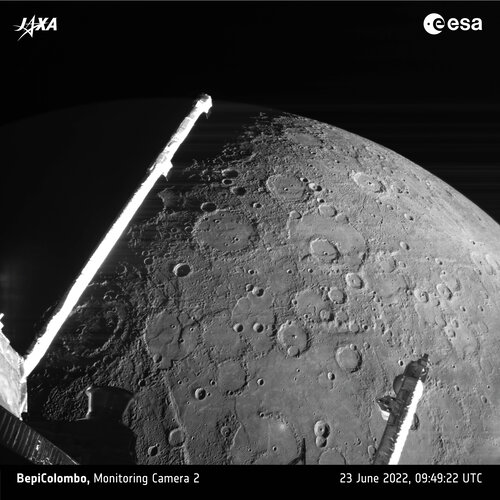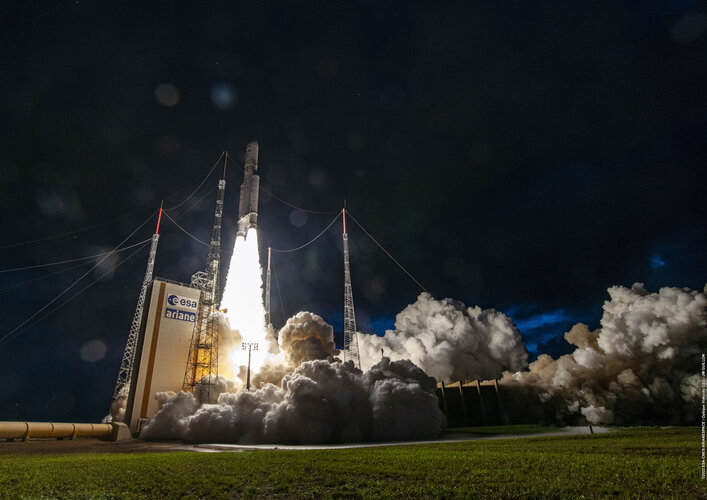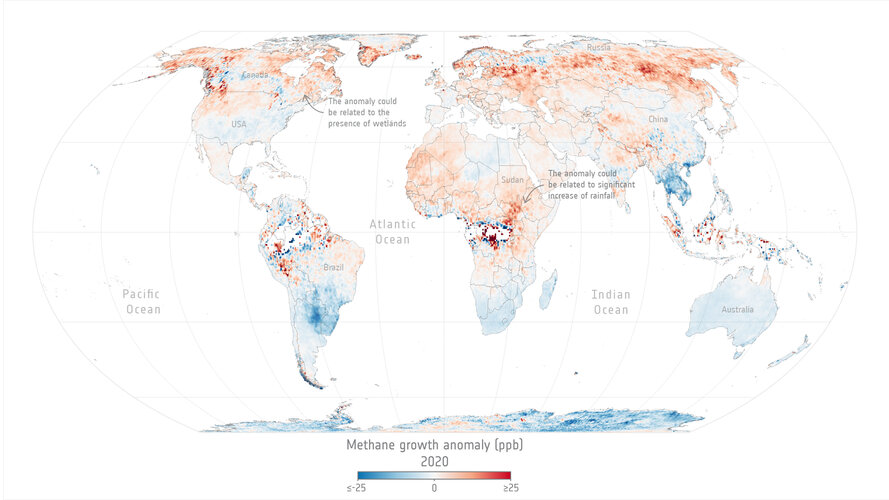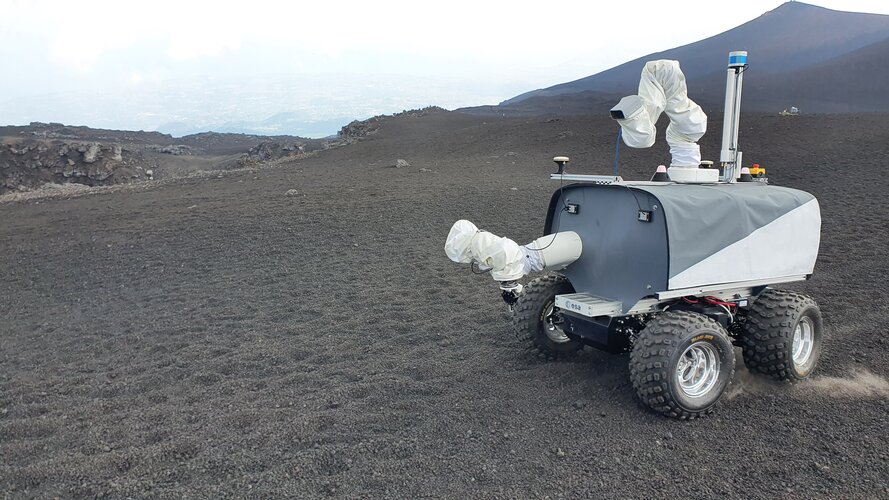
Copernical Team
Thursday, 23 June 2022 13:00
BepiColombo surveys Mercury’s rich geology
 Image:
BepiColombo surveys Mercury’s rich geology
Image:
BepiColombo surveys Mercury’s rich geology
Published in
News
Tagged under
Thursday, 23 June 2022 08:15
Ariane 5 orbits Malaysian, Indian telecoms payloads

Ariane 5 has delivered two telecommunications satellites, MEASAT-3d and GSAT-24, into their planned geostationary transfer orbits.
Published in
News
Tagged under
Thursday, 23 June 2022 11:45
Methane levels surged in 2020 despite lockdowns

Levels of methane, the second most important greenhouse gas in our atmosphere, continued their unrelenting rise in 2020 despite the economic slowdown caused by the COVID-19 pandemic.
A team of scientists, from the University of Leeds, have used data from the Copernicus Sentinel-5P satellite to pinpoint locations with large surges of methane emissions. These findings were presented during ESA’s Living Planet Symposium which took place last month in Bonn, Germany.
Published in
News
Tagged under
Thursday, 23 June 2022 13:38
Lunar science stirring on Mount Etna
 Image:
Lunar science stirring on Mount Etna
Image:
Lunar science stirring on Mount Etna
Published in
News
Tagged under
Thursday, 23 June 2022 10:29
Exploring globular clusters with the lens of asteroseismology
Bologna, Italy (SPX) Jun 23, 2022
 Asteroseismology - one of the most fascinating and sophisticated methods for measuring the mass of stars, and by extension, their age - can also be successfully used to reveal the characteristics of the stars within globular clusters: very large groups of stars (in the order of hundreds of thousands) condensed in a relatively small space and all at approximately the same distance from us.
Asteroseismology - one of the most fascinating and sophisticated methods for measuring the mass of stars, and by extension, their age - can also be successfully used to reveal the characteristics of the stars within globular clusters: very large groups of stars (in the order of hundreds of thousands) condensed in a relatively small space and all at approximately the same distance from us.
 Asteroseismology - one of the most fascinating and sophisticated methods for measuring the mass of stars, and by extension, their age - can also be successfully used to reveal the characteristics of the stars within globular clusters: very large groups of stars (in the order of hundreds of thousands) condensed in a relatively small space and all at approximately the same distance from us.
Asteroseismology - one of the most fascinating and sophisticated methods for measuring the mass of stars, and by extension, their age - can also be successfully used to reveal the characteristics of the stars within globular clusters: very large groups of stars (in the order of hundreds of thousands) condensed in a relatively small space and all at approximately the same distance from us.
Published in
News
Tagged under
Thursday, 23 June 2022 10:29
You can help scientists study the atmosphere on Jupiter
Minneapolis MN (SPX) Jun 23, 2022
 A new citizen science project, led by researchers at the University of Minnesota Twin Cities with support from NASA, allows volunteers to play an important role in helping scientists learn more about the atmosphere on Jupiter. Citizen scientists can help astrophysicists categorize tens of thousands of stunning images taken from the Juno spacecraft with just a web browser.
The planet Jupite
A new citizen science project, led by researchers at the University of Minnesota Twin Cities with support from NASA, allows volunteers to play an important role in helping scientists learn more about the atmosphere on Jupiter. Citizen scientists can help astrophysicists categorize tens of thousands of stunning images taken from the Juno spacecraft with just a web browser.
The planet Jupite
 A new citizen science project, led by researchers at the University of Minnesota Twin Cities with support from NASA, allows volunteers to play an important role in helping scientists learn more about the atmosphere on Jupiter. Citizen scientists can help astrophysicists categorize tens of thousands of stunning images taken from the Juno spacecraft with just a web browser.
The planet Jupite
A new citizen science project, led by researchers at the University of Minnesota Twin Cities with support from NASA, allows volunteers to play an important role in helping scientists learn more about the atmosphere on Jupiter. Citizen scientists can help astrophysicists categorize tens of thousands of stunning images taken from the Juno spacecraft with just a web browser.
The planet Jupite
Published in
News
Tagged under
Thursday, 23 June 2022 10:29
NASA's Webb to Uncover Riches of the Early Universe
Baltimore MD (SPX) Jun 23, 2022
 For decades, telescopes have helped us capture light from galaxies that formed as far back as 400 million years after the big bang - incredibly early in the context of the universe's 13.8-billion-year history. But what were galaxies like that existed even earlier, when the universe was semi-transparent at the beginning of a period known as the Era of Reionization?
NASA's next flagship obse
For decades, telescopes have helped us capture light from galaxies that formed as far back as 400 million years after the big bang - incredibly early in the context of the universe's 13.8-billion-year history. But what were galaxies like that existed even earlier, when the universe was semi-transparent at the beginning of a period known as the Era of Reionization?
NASA's next flagship obse
 For decades, telescopes have helped us capture light from galaxies that formed as far back as 400 million years after the big bang - incredibly early in the context of the universe's 13.8-billion-year history. But what were galaxies like that existed even earlier, when the universe was semi-transparent at the beginning of a period known as the Era of Reionization?
NASA's next flagship obse
For decades, telescopes have helped us capture light from galaxies that formed as far back as 400 million years after the big bang - incredibly early in the context of the universe's 13.8-billion-year history. But what were galaxies like that existed even earlier, when the universe was semi-transparent at the beginning of a period known as the Era of Reionization?
NASA's next flagship obse
Published in
News
Tagged under
Thursday, 23 June 2022 10:29
China launches new test satellite
Jiuquan (XNA) Jun 23, 2022
 China on Wednesday sent a new satellite into space from the Jiuquan Satellite Launch Center in northwest China.
The Tianxing-1 test satellite was launched by a Kuaizhou-1A carrier rocket at 10:08 a.m. (Beijing Time) and entered the planned orbit.
The satellite is mainly used for experiments such as space environment detection.
It was the 15th flight mission of the Kuaizhou-1A r
China on Wednesday sent a new satellite into space from the Jiuquan Satellite Launch Center in northwest China.
The Tianxing-1 test satellite was launched by a Kuaizhou-1A carrier rocket at 10:08 a.m. (Beijing Time) and entered the planned orbit.
The satellite is mainly used for experiments such as space environment detection.
It was the 15th flight mission of the Kuaizhou-1A r
 China on Wednesday sent a new satellite into space from the Jiuquan Satellite Launch Center in northwest China.
The Tianxing-1 test satellite was launched by a Kuaizhou-1A carrier rocket at 10:08 a.m. (Beijing Time) and entered the planned orbit.
The satellite is mainly used for experiments such as space environment detection.
It was the 15th flight mission of the Kuaizhou-1A r
China on Wednesday sent a new satellite into space from the Jiuquan Satellite Launch Center in northwest China.
The Tianxing-1 test satellite was launched by a Kuaizhou-1A carrier rocket at 10:08 a.m. (Beijing Time) and entered the planned orbit.
The satellite is mainly used for experiments such as space environment detection.
It was the 15th flight mission of the Kuaizhou-1A r
Published in
News
Tagged under
Thursday, 23 June 2022 10:29
Key milestones achieved in Manned-Unmanned Teaming for future air power
Paris, France (SPX) Jun 22, 2022
 The ability to task unmanned systems from a manned aircraft is an important force multiplier in Airbus' vision for future air power, with a wide range of applications extending to combat scenarios and beyond.
As a pioneer in the realm of Manned-Unmanned Teaming (MUM-T), Airbus has developed an ambitious technological roadmap to make this innovative concept - which boosts the effectiveness
The ability to task unmanned systems from a manned aircraft is an important force multiplier in Airbus' vision for future air power, with a wide range of applications extending to combat scenarios and beyond.
As a pioneer in the realm of Manned-Unmanned Teaming (MUM-T), Airbus has developed an ambitious technological roadmap to make this innovative concept - which boosts the effectiveness
 The ability to task unmanned systems from a manned aircraft is an important force multiplier in Airbus' vision for future air power, with a wide range of applications extending to combat scenarios and beyond.
As a pioneer in the realm of Manned-Unmanned Teaming (MUM-T), Airbus has developed an ambitious technological roadmap to make this innovative concept - which boosts the effectiveness
The ability to task unmanned systems from a manned aircraft is an important force multiplier in Airbus' vision for future air power, with a wide range of applications extending to combat scenarios and beyond.
As a pioneer in the realm of Manned-Unmanned Teaming (MUM-T), Airbus has developed an ambitious technological roadmap to make this innovative concept - which boosts the effectiveness
Published in
News
Tagged under
Thursday, 23 June 2022 10:29
Globalstar announces successful launch of spare satellite
Covington LA (SPX) Jun 21, 2022
 Globalstar, Inc. (NYSE American: GSAT), a leading provider of satellite-powered innovation, has announced the successful launch of the FM-15 spare satellite from Cape Canaveral's Kennedy Space Center. FM-15 is the 25th and final satellite of Globalstar's second-generation constellation, which was manufactured and stored by Thales Alenia Space.
The satellite is expected to remain as an in-o
Globalstar, Inc. (NYSE American: GSAT), a leading provider of satellite-powered innovation, has announced the successful launch of the FM-15 spare satellite from Cape Canaveral's Kennedy Space Center. FM-15 is the 25th and final satellite of Globalstar's second-generation constellation, which was manufactured and stored by Thales Alenia Space.
The satellite is expected to remain as an in-o
 Globalstar, Inc. (NYSE American: GSAT), a leading provider of satellite-powered innovation, has announced the successful launch of the FM-15 spare satellite from Cape Canaveral's Kennedy Space Center. FM-15 is the 25th and final satellite of Globalstar's second-generation constellation, which was manufactured and stored by Thales Alenia Space.
The satellite is expected to remain as an in-o
Globalstar, Inc. (NYSE American: GSAT), a leading provider of satellite-powered innovation, has announced the successful launch of the FM-15 spare satellite from Cape Canaveral's Kennedy Space Center. FM-15 is the 25th and final satellite of Globalstar's second-generation constellation, which was manufactured and stored by Thales Alenia Space.
The satellite is expected to remain as an in-o
Published in
News
Tagged under

